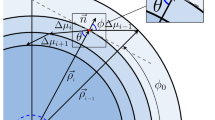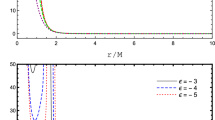Abstract
Modern meta-materials allow one to construct electromagnetic media with almost arbitrary bespoke permittivity, permeability, and magneto-electric tensors. If (and only if) the permittivity, permeability, and magneto-electric tensors satisfy certain stringent compatibility conditions, can the meta-material be fully described (at the wave optics level) in terms of an effective Lorentzian metric—an analogue spacetime. We shall consider some of the standard black-hole spacetimes of primary interest in general relativity, in various coordinate systems, and determine the equivalent meta-material susceptibility tensors in a laboratory setting. In static black hole spacetimes (Schwarzschild and the like) certain eigenvalues of the susceptibility tensors will be seen to diverge on the horizon. In stationary black hole spacetimes (Kerr and the like) certain eigenvalues of the susceptibility tensors will be seen to diverge on the ergo-surface.
Similar content being viewed by others
Notes
To proceed, we could in principle perform a “local” Lorentz transformation from the rest frame V of the medium into the laboratory frame—along the lines of Appendix B of reference [1], but the “matching” analysis presented here is more straightforward.
References
Schuster, S., Visser, M.: Effective metrics and a fully covariant description of constitutive tensors in electrodynamics. Phys. Rev. D 96, 124019 (2017). https://doi.org/10.1103/PhysRevD.96.124019. arXiv:1706.06280 [gr-qc]
Gordon, W.: Zur Lichtfortpflanzung nach der Relativitätstheorie. Ann. Phys. 377(22), 421–456 (1923). https://doi.org/10.1002/andp.19233772202
Landau, L.D., Lifshitz, E.M.: The Classical Theory of Fields, 3rd edn. Pergamon Press, Oxford (1971)
Plebański, J.: Electromagnetic waves in gravitational fields. Phys. Rev. 118, 1396–1408 (1960)
Plebanśki, J.: Lectures on Nonlinear Electrodynamics. Nordita, Copenhagen (1970)
de Felice, F.: On the gravitational field acting as an optical medium. Gen. Relativ. Gravit. 2, 347–357 (1971)
Skrotskii, G.V.: The influence of gravitation on the propagation of light. Sov. Phys. Dokl. 2, 226–229 (1957)
Balazs, N.L.: Effect of a gravitational field, due to a rotating body, on the plane of polarization of an electromagnetic wave. Phys. Rev. 110, 236–239 (1958)
Anderson, J.L., Spiegel, E.A.: Radiative transfer through a flowing refractive medium. Astrophys. J. 202, 454–464 (1975)
Pham, Q.M.: Sur les équations de l’electromagné dans la materie. C. R. Hebd. Seanc. Acad. Sci. 242, 465–467 (1956)
Thompson, R.T., Frauendiener, J.: Dielectric analog space-times. Phys. Rev. D 82, 124021 (2010). arXiv:1010.1587 [gr-qc]
Thompson, R.T., Cummer, S.A., Frauendiener, J.: Generalized transformation optics of linear materials. J. Opt. 13, 055105 (2011). arXiv: 1006.3364 [physics.optics]
Thompson, R.T., Cummer, S.A., Frauendiener, J.: A completely covariant approach to transformation optics. J. Opt. 13, 024008 (2011). arXiv:1006.3118 [physics.optics]
Thompson, R.T., Fathi, M.: Shrinking cloaks in expanding space-times: the role of coordinates and the meaning of transformations in transformation optics. Phys. Rev. A 92(1), 013834 (2015). https://doi.org/10.1103/PhysRevA.92.013834. arXiv:1506.08507 [physics.optics]
Fathi, M., Thompson, R.T.: Cartographic distortions make dielectric spacetime analog models imperfect mimickers. Phys. Rev. D 93(12), 124026 (2016). https://doi.org/10.1103/PhysRevD.93.124026. arXiv:1602.08341 [gr-qc]
Thompson, R.T.: Covariant Electrodynamics in Linear Media: Optical Metric. arXiv:1712.06872 [gr-qc]
Leonhardt, U., Piwnicki, P.: Optics of nonuniformly moving media. Phys. Rev. A 60, 4301 (1999). https://doi.org/10.1103/PhysRevA.60.4301
Unruh, W.G.: Experimental black hole evaporation. Phys. Rev. Lett. 46, 1351 (1981). https://doi.org/10.1103/PhysRevLett.46.1351
Visser, M.: Acoustic Propagation in Fluids: An Unexpected Example of Lorentzian Geometry. arXiv:gr-qc/9311028
Visser, M.: Acoustic black holes: horizons, ergospheres, and Hawking radiation. Class. Quantum Gravit. 15, 1767 (1998). https://doi.org/10.1088/0264-9381/15/6/024. arXiv:gr-qc/9712010
Barceló, C., Liberati, S., Visser, M.: Analog gravity from Bose–Einstein condensates. Class. Quantum Gravit. 18, 1137 (2001). https://doi.org/10.1088/0264-9381/18/6/312. arXiv:gr-qc/0011026
Barceló, C., Liberati, S., Visser, M.: Probing semiclassical analog gravity in Bose-Einstein condensates with widely tunable interactions. Phys. Rev. A 68, 053613 (2003). https://doi.org/10.1103/PhysRevA.68.053613. arXiv:cond-mat/0307491
Visser, M., Molina-París, C.: Acoustic geometry for general relativistic barotropic irrotational fluid flow. New J. Phys. 12, 095014 (2010). https://doi.org/10.1088/1367-2630/12/9/095014. arXiv:1001.1310 [gr-qc]
Barceló, C., Liberati, S., Visser, M.: Analogue gravity. Living Rev. Rel. 8 12 (2005) [Living Rev. Rel. 14 (2011) 3] https://doi.org/10.12942/lrr-2005-12. arXiv:gr-qc/0505065
Visser, M., Barceló, C., Liberati, S.: Analog models of and for gravity. Gen. Relativ. Gravit. 34, 1719 (2002). https://doi.org/10.1023/A:1020180409214. arXiv:gr-qc/0111111
Visser, M.: Survey of analogue spacetimes. Lect. Notes Phys. 870, 31 (2013). https://doi.org/10.1007/978-3-319-00266-8_2. arXiv:1206.2397 [gr-qc]
Boersma, S., Dray, T.: Slicing, threading and parametric manifolds. Gen. Relativ. Gravit. 27, 319 (1995). https://doi.org/10.1007/BF02109128. arXiv:gr-qc/9407020
Bejancu, A., Calin, C.: On the (\(1+3\)) threading of spacetime with respect to an arbitrary timelike vector field. Eur. Phys. J. C 75(4), 159 (2015). https://doi.org/10.1140/epjc/s10052-015-3390-0
Gharechahi, R., Nouri-Zonoz, M., Tavanfar, A.: A tale of two velocities: threading vs slicing. Int. J. Geom. Methods Mod. Phys. 15, 1850047 (2018). https://doi.org/10.1142/S0219887818500470. arXiv:1510.02359 [gr-qc]
Reznik, B.: Origin of the thermal radiation in a solid state analog of a black hole. Phys. Rev. D 62, 044044 (2000). https://doi.org/10.1103/PhysRevD.62.044044. arXiv:gr-qc/9703076
Rosquist, K.: A moving medium simulation of Schwarzschild black hole optics. Gen. Relativ. Gravit. 36, 1977 (2004). https://doi.org/10.1023/B:GERG.0000036055.82140.06. arXiv:gr-qc/0309104
Giacomelli, L., Liberati, S.: Rotating black hole solutions in relativistic analogue gravity. Phys. Rev. D 96(6), 064014 (2017). https://doi.org/10.1103/PhysRevD.96.064014. arXiv:1705.05696 [gr-qc]
Jacobson, T., Kang, G.: Conformal invariance of black hole temperature. Class. Quantum Gravit. 10, L201 (1993). https://doi.org/10.1088/0264-9381/10/11/002. arXiv:gr-qc/9307002
Hossenfelder, S., Zingg, T.: Analogue gravity models from conformal rescaling. Class. Quantum Gravit. 34(16), 165004 (2017). https://doi.org/10.1088/1361-6382/aa7e12. arXiv:1703.04462 [gr-qc]
Wiltshire, D.L., Visser, M., Scott, S.M. (eds.): The Kerr Spacetime: Rotating Black Holes in General Relativity. Cambridge University Press, Cambridge (2009)
Visser, M.: The Kerr Spacetime: A Brief Introduction. arXiv:0706.0622 [gr-qc]. Published in [35]
Doran, C.: A New form of the Kerr solution. Phys. Rev. D 61, 067503 (2000). https://doi.org/10.1103/PhysRevD.61.067503. arXiv:gr-qc/9910099
Hamilton, A.J.S., Lisle, J.P.: The river model of black holes. Am. J. Phys. 76, 519 (2008). https://doi.org/10.1119/1.2830526. arXiv:gr-qc/0411060
Acknowledgements
MV acknowledges financial support from the Marsden Fund administered by the Royal Society of New Zealand. SS was also supported by a Victoria University of Wellington Ph.D. Scholarship.
Author information
Authors and Affiliations
Corresponding author
Rights and permissions
About this article
Cite this article
Schuster, S., Visser, M. Bespoke analogue space-times: meta-material mimics. Gen Relativ Gravit 50, 55 (2018). https://doi.org/10.1007/s10714-018-2376-2
Received:
Accepted:
Published:
DOI: https://doi.org/10.1007/s10714-018-2376-2




